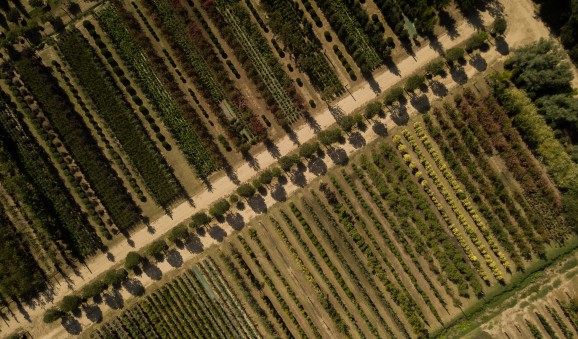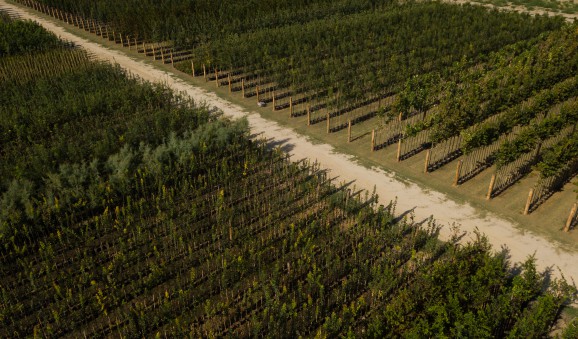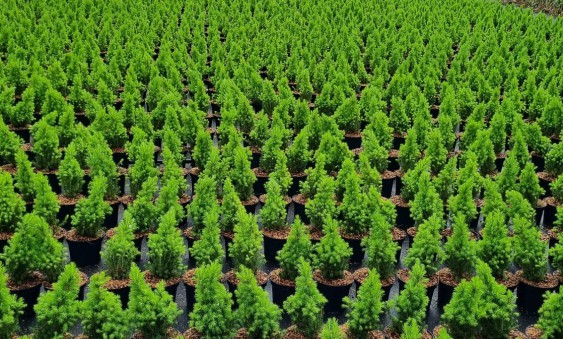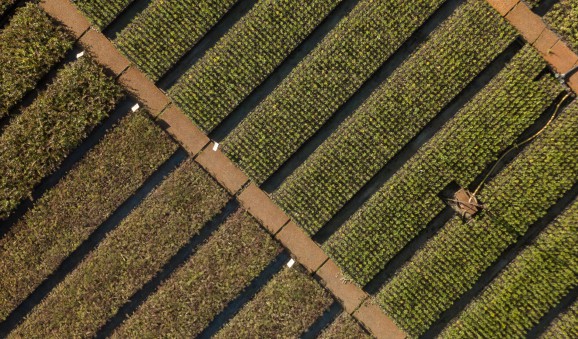- HOME >
- NEWS >
- Cultivation 13-07-2024
Pot and container cultivation: indispensible in the nursery stock industry

This new cultivation method also allowed people without gardens to place ornamental plants in attractive pots on their balconies or terraces. While the traditional sales season for nursery stock products spanned four to five months, pot and container cultivation extended this period to at least eight to nine months. Garden centres and landscapers can now offer plants at times when they naturally have ornamental value, creating new retail opportunities for visually appealing plants that are perfect for impulse purchases.
Special fertilisation for pot and container cultivation
Although growing plants in pots and containers is in some ways ‘easier’ than growing them in open ground, there are still important considerations. Plants in small pots or large containers, as well as balcony and indoor plants, are typically grown in substrates and therefore require special fertilisers. To ensure a consistent supply of nutrients over several months, slow-release and controlled-release fertilisers can be applied. These can be mixed into the substrate by the potting soil supplier or dosed by the grower. Fertigation, which involves adding fertilizers through the irrigation system, can also be used as the main fertilisation method or to adjust nutrition during the cultivation period. In line with special fertilisation, there is also the question of how pot and container cultivation contributes to organic farming. The market, including public green spaces, shows an increased demand for organically grown nursery stock products. In response, the pot and container sector is offering a growing and diverse range of organic shrubs, perennials, forest and hedge plants, and standard trees.
Proper watering techniques
In recent years, there have been significant changes in watering practices. While growers once relied entirely on rainfall, more controlled watering methods have since been developed to achieve more consistent harvests. Effective watering is a crucial aspect of pot and container cultivation.
Pot and container cultivation n now encompasses a wide variety of pot sizes and plant types. The appropriate amount of water is determined by how much moisture the plant evaporates, the larger the leaf area, the greater the evaporation. The climate and light intensity at a location also play roles in a plant’s evaporation rate. Furthermore, the buffering capacity of the potting soil or substrate used is a factor. In pot and container cultivation, precision technology is often employed by growers to determine the optimal water flow for the soil and plants to achieve optimal growth and uniformity.
Sustainability in pot and container cultivation
The use of peat as material for the substrate in pot and container cultivation is common. However, this practice is increasingly criticised, especially internationally. There is growing societal pressure to replace peat in potting soils and substrates due to its finite nature and the negative environmental impact of its extraction. Transitioning to a sustainable horticultural sector requires growers to move away from using peat. Nonetheless, there are not many alternatives currently available, and those that do exist are not suitable for all types of cultivation. Growers are thus actively searching for suitable alternatives. Sustainability is crucial for pot and container cultivation as it drives the search for other growing media.
In this context, the LTO Workgroup for Trees, Perennials, and Summer Flowers, LTO Greenhouse Horticulture, Plantum, and Royal Flora Holland organised an online summit in January titled ‘Peat in potting soil and the search for alternative substrates’. Coconut fibre, a by-product of the coconut industry, is one option, but its sustainability is questionable given the long shipping distances. Wageningen University & Research (WUR) is currently inventorying which (waste) products available locally could be suitable as substrates.
ILVO Vlaanderen has reported positive results: the natural microorganisms in peat alternatives like compost and (natural) management residues can stimulate plant growth and suppress plant diseases more effectively than peat. This was shown by the doctoral research of Steffi Pot at KU Leuven Campus Geel in collaboration with ILVO and PCS. Additionally, various methods (e.g., fertilisation and the addition of artificial root exudates) can significantly influence these microorganisms to further enhance plant growth and health. Compost and management residues (biomass resulting from the management of natural areas, such as heathlands and forests) are also promising alternatives to peat.
Pot and container cultivation: essential for the future
Looking at trends, pot and container cultivation will continue to play a significant role in the future. This form of cultivation will evolve in response to market demand and the need for sustainability in the industry. All the ingredients for a successful future are present. It is up to the industry to handle these ingredients smartly, effectively, and efficiently. Based on past performance, we can trust that they will succeed!
What do our participants think?
Gerrit Tessemaker of De Buurte Nurseries, Oene, heads a nursery specialising in evergreen garden plants and hedge plants. The company grows and sells a wide range of plants to professional parties like garden centres, landscapers, and wholesalers both domestically and internationally. The nursery spans 245 hectares across four locations: Oene, Heerde, Uddel, and Twello. Thirty dedicated employees work full-time, with additional flex workers during peak periods. “We try to grow our products as profitably as possible,” says Gerrit. “We’ve made several smart economic choices. Most of our machinery and rolling stock are owned. We also adapt based on market conditions. By mechanising and minimising manual labour—since labour is costly and hard to find—we strive to keep costs low.” Consequently, the company has not yet adopted a drip irrigation system. Gerrit explains: “We’re in a wildlife-rich area, which is nice, but if you discover that rabbits have bitten through your drip lines, your plants will be dried out.” For now, irrigation is still done using reels when necessary. Regarding sustainability, Gerrit says: “Growing a good plant starts with a good start. We use stable manure and green manure. Weeding is done with a hoe or a weeding harrow. Where necessary, we use low-volume spraying to minimise the use of chemicals. We’re also affiliated with MPS. As for organic farming; transitioning requires a market demand, and we haven’t seen enough of that demand from our customers yet. But if that becomes the demand, we’ll have to adapt.” Gerrit doesn’t see a complete shift to pot cultivation for their crops, primarily because of the higher cost of pot-grown plants and the fact that open-field plants are simply ‘heavier/ more robust.’ “A trend we do see continuing,” adds Gerrit, “is that customers are requesting smaller batches more frequently to keep fresher stock at garden centres.”
The Italian nursery Vivai Guagno grows plants in pots and containers as well as in open soil. Root balls have been a significant part of the business, but container growing has expanded significantly. Gloria Guagno sees year-round planting as a major advantage of container cultivation. “It mitigates the effects of shorter winters and allows customers to optimise their leisure time. It also offers logistical benefits, as containers simplify order management for small quantities and uncertain loading dates.”
The company’s headquarters are in Santa Giustina in Colle (Padova), where forest plants have been produced in containers for 40 years. Here, seeds are started and then grown in smaller containers (up to CLT10). To complement their forestry tradition, Vivai Guagno offers a refreshed assortment of young trees intended for further propagation or urban reforestation. Over time, the range has expanded to include ornamental species and grafted plants. In their second nursery in Comacchio (Ferrara), the production of CLT15 to CLT1500 now covers 30 hectares. Here, multi-stemmed trees, trees, and shrubs are grown to complete their assortment.
“Watering is usually done via drip irrigation and sprinklers for smaller pots,” says Gloria. “Systems have been chosen to minimise water loss, and further investments in modernising less efficient plants are planned. The use of crop protection products is limited, as most cultivated species are resistant to pests, and we prefer to grow organically.”
Heyeveld Nursery, based in As, Belgium, was founded in the 1930s when Mathijs Peters and his wife Jeanne Deville started growing and trading vegetable plants. About three decades later, their sons transitioned the business to growing garden plants and landscaping. Today, the company is led by Leon Peters and Jan Nijs, the latter being the first non-family member in management. Heyeveld Nursery now grows hardy garden plants in various pot sizes and in open soil on about 100 hectares. Their range includes hedge and grafted conifers, various shrubs, and grasses. Their clients include wholesalers, exporters, garden and plant centres, and other tree nurseries.
Sustainability and environmental care are important to the company. That is why they have conducted a carbon footprint assessment, a measure of total emissions. Emissions include various greenhouse gases such as methane, F-gases, and CO2. As agreed upon in the Paris Climate Agreement, the European Union aims to be climate neutral by 2050, meaning no net greenhouse gas emissions. “Based on our carbon footprint results, we have started reducing our diesel consumption and using biodiesel as much as possible,” says Jan Nijs. “We also changed our office heating system to reduce gas usage.”
Irrigation is a focus at Heyeveld Nursery. Drip irrigation is used for open-soil cultivation, and for pot and container cultivation, both drip and overhead irrigation are used, with all unused water being neatly returned to large water containers to avoid waste. Jan Nijs: “We are not currently considering transitioning to organic farming, but we are gradually moving towards more sustainability. This includes reducing the use of crop protection products and further advancing automation and mechanisation.” The company recently introduced an additional overhead tractor and a pruning machine for shrubs and bulbs. “Technology continues to advance,” says Jan, “I mainly see ongoing improvements to existing technology rather than major changes. Regarding cultivation, this year has shown again that open-soil cultivation is not straightforward due to climate changes and extreme weather conditions. Growing in pots is easier and has the added advantage of year-round availability.”
On behalf of Trade Fair GrootGroenPlus: Corianne Oudijk, treasurer
“At GGP, there are many growers who use pot and container cultivation, both from the Netherlands and abroad. They make up a large part of the trade fair. They show a high-quality and complete range.”


